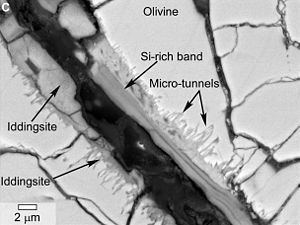| Yamato 000593 | |
|---|---|
 Yamato 000593 meteorite—13.7 kg (30 lb). The cube is 1 cm (0.39 in) (NASA; 2012). | |
| Type | Achondrite |
| Structural classification | Igneous [1] |
| Class | Martian meteorite [2] |
| Group | Nakhlite [2] |
| Composition | pyroxene 85% [1] olivine 10% |
| Shock stage | S3 [1] |
| Weathering grade | B [3] |
| Country | Antarctica [2] |
| Region | Yamato Glacier [2] |
| Coordinates | 71°30′S35°40′E / 71.500°S 35.667°E [3] [4] |
| Observed fall | No |
| Fall date | 50,000 years ago [2] |
| Found date | 2000 [2] |
| TKW | 13.7 kg (30 lb) [2] |
Yamato 000593 (or Y000593) is the second largest meteorite from Mars found on Earth. [2] [5] [6] Studies suggest the Martian meteorite was formed about 1.3 billion years ago from a lava flow on Mars. [7] An impact occurred on Mars about 11 million years ago [7] and ejected the meteorite from the Martian surface into space. The meteorite landed on Earth in Antarctica about 50,000 years ago. The mass of the meteorite is 13.7 kg (30 lb) and has been found to contain evidence of past water alteration. [2] [5] [6] [8]
Contents
At a microscopic level, areas of the meteorite with spheres are rich in carbon compared to surrounding areas lacking such spheres. The carbon-rich spheres and the observed micro-tunnels may have been formed by biotic activity, according to NASA scientists. [2] [5] [6]


